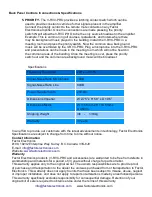
www.factorelectronics.com
Back Panel Controls and Connections
?
MIC PHT-
This applies 24V DC phantom power to pin 2 + and pin 3 – of the
XLR microphone input. Phantom power is used to power condenser
microphones such as podium microphones, choir microphones and some
stage/studio microphones. Dynamic microphones do not require phantom
power to operate. Always consult the microphone manual or manufacturer to
determine the correct setting for the microphone used.
?
-15dB
– Set this dipswitch to ON when using MIC PHT and connecting a
condenser microphone. Condenser microphones provide a higher output level
that may overload the microphone pre-amp. The -15dB switch reduces the
microphone input level by 15dB to avoid overload.
?
100Hz CUT
Set this dipswitch to ON for microphones that will be used for
speech or presentations. This will cut low frequencies below 100Hz at 18dB
per octave. This is useful for removing unwanted low frequency noise caused
from handling the microphone or rumbles caused by sound transferring from
the floor to the mic stand and then to the microphone.
?
RVC
Set this dip switch to ON when using a single V-RVC with a Factor
Electronics amplifier. This switch enables the remote master volume control
feature of the V-RVC. When using multiple V-RVC's on a single amplifier you
must designate one V-RVC to be the master volume controller by setting the
switch to ON. All other V-RVC's must have this dipswitch set to OFF. If more
than one RVC is set to ON it will be impossible to control the master volume
of the amplifier. NOTE: To effectively control the master volume of the
amplifier from the V-RVC set the amplifier master volume to 75% or 2/3rds
full volume and control the overall level from the V-RVC. If the amplifier
master volume is set to OFF there will be no sound. Also if the amplifier
master volume is set too low the V-RVC will not be able to increase the
volume beyond the level that is set on the amplifier. The RVC acts like a
remote attenuator.
1.
2. OUT 1
- The V-RVC OUT1 is the main output of the preamplifier.
Connect this to the V-RVC input on the back panel of any Factor
Electronics amplifier. It is also possible to daisy chain up to three
V-RVC pre-amplifiers to one amplifier by connecting the OUT1
to the IN1 on subsequent V-RVC pre-amplifiers in the daisy chain.
3. VOX SENS
- The V-RVC can automatically override other signals present
the amplifier. Set the priority dip-switch on the back panel of the amplifier
to on. Now the V-RVC will automatically override other signals. It may be
necessary to adjust the sensitivity of the override circuit. Turn the vox sens
screw clockwise to increase the sensitivity and counter clockwise to decrease
the sensitivity.
4. IN 1
- The V-RVC IN1 is the input for other V-RVC pre-amplifiers
in a daisy chain or an X-Music in-wall iPod dock .
Connect this to the V-RVC OUT1 on the back panel of other V-RVC
pre-amplifiers.
OFF



























